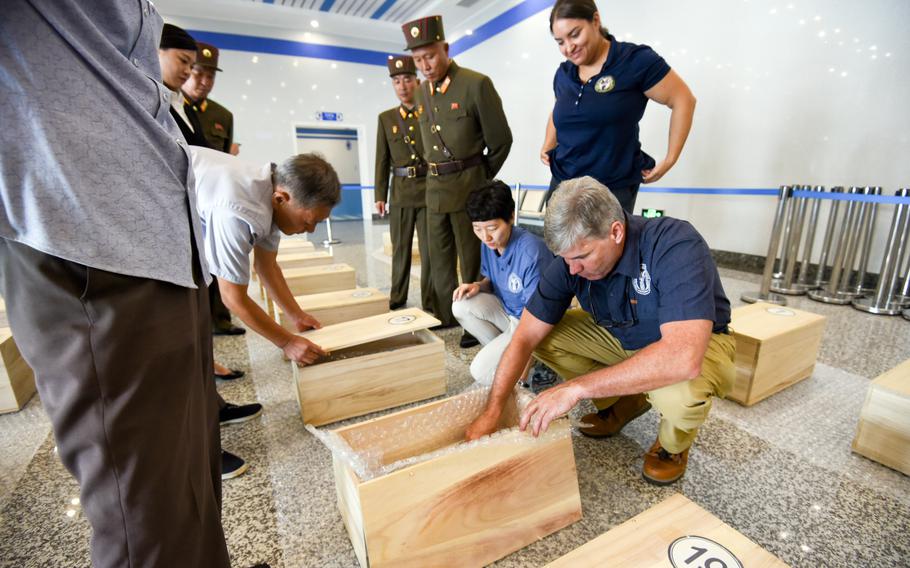
Forensic anthropologists with the Defense POW/MIA Accounting Agency review the contents of cases containing the possible remains of service members lost in the Korean War during a unilateral transfer in Wonsan, North Korea, in July 2018. (David J. Marshall/U.S. Army)
WASHINGTON — Pinned to Robin Piacine’s scarf was a black and white photo of a man she has never met.
“When I was young, my mother had a picture of him on her vanity. I asked her to tell me about him and she just broke down crying,” she said, gently touching the photo.
Piacine’s uncle, Army Sgt. William Charles Bradley, is presumed to be in an unmarked grave along a prisoner of war route in North Korea. He is among the remains of 5,300 troops who went missing in action while in North Korea in the 1950s.
“I don’t know that we will ever get him back,” Piacine said Thursday.
The Defense POW/MIA Accounting Agency, the Pentagon operation that oversees the recovery and identification of missing troops, hosted its annual government briefing on the Korean War and Cold War this week in Arlington, Va. More than 300 families in attendance represented a fraction of the 7,500 presumed missing from the Korean War. Another approximately 130 represented those missing from the Cold War.
To date, the DPAA has accounted for almost 700 soldiers missing during the Korean War. On Wednesday, the agency identified Army Cpl. Frederick Higgins, 20, of Bremerton, Wash. Higgins was killed during the Korean War and was accounted for on June 22, 2023. His remains were identified at the National Memorial Cemetery of the Pacific, also known as the Punchbowl, in Hawaii.
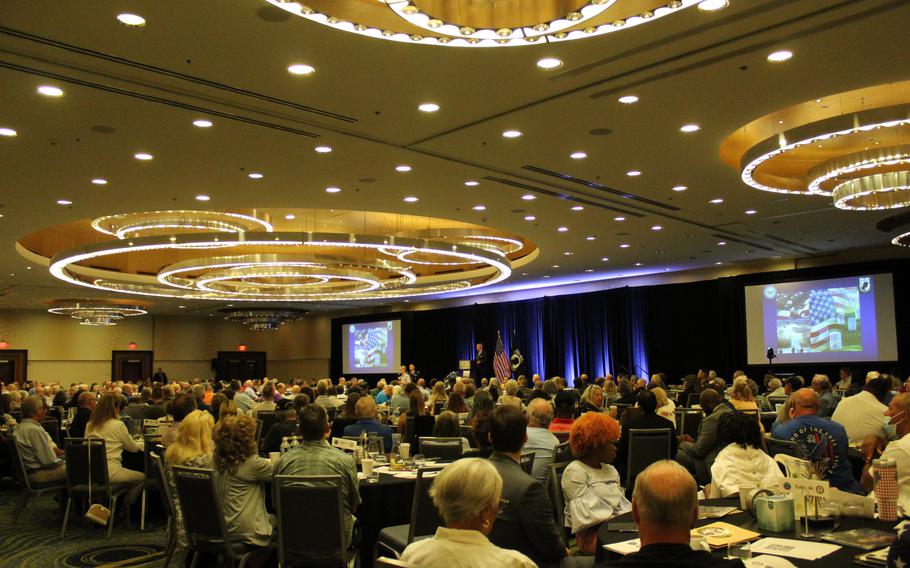
The Defense POW/MIA Accounting Agency, the Pentagon operation that oversees the recovery and identification of missing troops, hosted its annual government briefing on the Korean War and Cold War on Thursday, Aug. 15, 2024, and continuing Friday, Aug. 16, 2024, in Arlington, Va. More than 300 families in attendance represented a fraction of the 7,500 presumed missing from the Korean War. Another approximately 130 represented those missing from the Cold War. (Caitlyn Burchett/Stars and Stripes)
Families came to Arlington in hopes of receiving an update on the disinterment and identification of unknown remains suspected to be their loved ones, though most will never have the answers that they are seeking, said Kelly McKeague, director of the DPAA.
“We are at the mercy of geopolitics,” he said.
The U.S. worked with North Korea in the 1990s and 2000s to disinter and exchange the remains of unknown troops. John Byrd, director of scientific analysis for DPAA, estimated 92% of the remains that the agency has received from North Korea have been identified.
“The bad news is that these are finite resources,” he said. “As we have success with the remains that we’re disinterring and bringing into the lab, we will eventually successfully get through all of those.”
Byrd estimated that will happen in the next several years.
“We would love an opportunity to get another unilateral turnover or to see a breakthrough in diplomacy,” he said.
The last time that the DPAA had access to North Korea was in 2005. But in 2018, the agency received 55 boxes of remains from North Korea. The DPAA has been unsuccessful in communicating with North Korea since then to coordinate additional exchanges.
“Will the majority of the families continue to be disappointed? Absolutely,” McKeague said.
But he said, if China is evidence, there is hope.
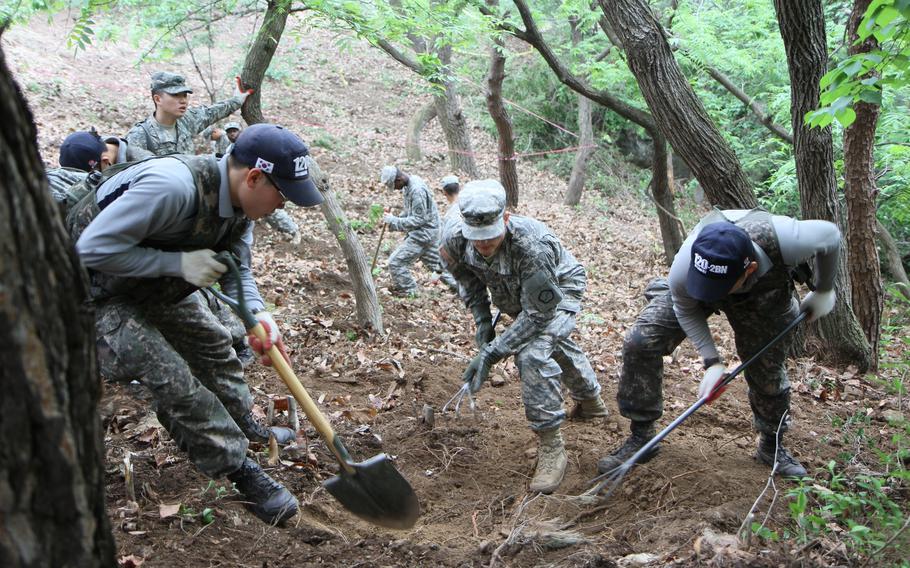
U.S. soldiers participate in an excavation operation for remains with South Korean troops in South Korea in 2014. (Joel Changhoon Lee/19th Expeditionary Sustainment Command)
In January, China resumed cooperating with the DPAA. There was an archival exchange in May of remains believed to be from World War II. Now, there is a DPAA team working at an excavation site in Hunan, a providence in southern China.
Additional sites in Yangon, a Chinese providence near the border of North Korea, have been identified as the resting grounds for U.S. Air Force troops lost during the Korean War.
McKeague said it is the DPAA’s hope that this “people-to-people” cooperation with China will translate to North Korea.
“At the very core of each of us, our humanity is this need to connect and this need to be whole,” McKeague said. “Forty-six countries, to include China, view this in that same light.”
On Thursday during the annual event, hundreds of family members wore tags bearing their name and that of their missing loved one — a thread of shared grief connecting them across generations.
Amy Shepherd Winston was there to represent her uncle, Army Pfc. Johnny Street. She was first contacted by the DPAA in 2015 about providing a DNA sample.
“I just want to say his name,” Winston said, addressing the room of family members.
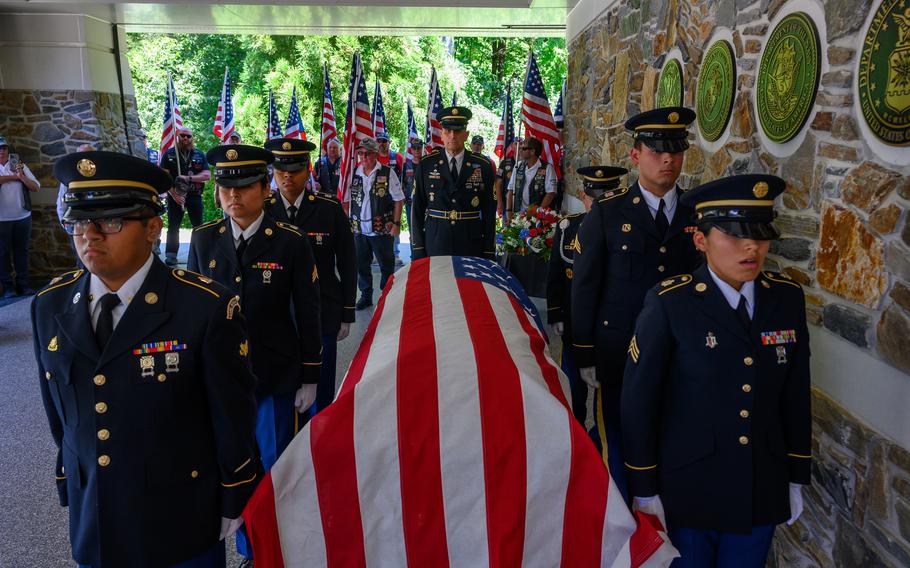
A ceremony for Army Pfc. Anthony J. Lopa was held at the Brigadier General William C. Doyle Veterans Memorial Cemetery in Wrightstown, N.J., on June 28, 2024. Lopa of North Arlington, N.J., was killed in action during the Korean War on Aug. 31, 1950. His remains were accounted for July 21, 2023. (Michael Schwenk/U.S. Army National Guard)
At another table, David Murray stood to say he was there to represent his brother, Army Pfc. Duane Murray. Murray was 11 years old when the family was notified his brother was missing in action. He has dedicated years to finding out what happened, learning his brother was among a squad overtaken by Chinese troops in North Korea.
“My brother made the ultimate sacrifice for this country,” Murray said.
Near the front of the room, Josephine Fuentes and Manual Baldonado listened to the accounts of others. Fuentes’ hands were lined with age, and she indicated she was hard of hearing. Baldonado, two years her senior, was slumped in a wheelchair. The pair, both in their 80s, made the journey from California to honor their brother, Army Cpl. Joe Baldonado, who was 18 years old when he went to war.
“He was just a skinny guy, real little. I remember he was always taking his shirt off, flexing his muscles,” said Fuentes, who was 8 at the time.
The corporal’s remains are believed to be in the Punchbowl in Hawaii. Baldonado estimated the family was first contacted by the DPAA more than 10 years ago, requesting DNA samples. But they said they have been seeking answers since late 1950 when soldiers knocked on the door of their family home with the telegram that told them their brother was missing in action.
“You never give up,” Baldonado said. “It is possible they will find him — with technology, you never know.”
Later this year, the Defense Department’s DNA identification laboratory will bring online a new DNA sequencing technology that will make it easier to identify chemically damaged remains at the National Memorial Cemetery of the Pacific. The laboratory identifies service members who have died in operations now, but it also works closely with the DPAA to identify those who have been missing for decades. Previously, DNA had to be sequenced with maternal samples, but technology like what Ancestry.com uses will allow the DPAA to use paternal samples.
Tim McMahon, director of the Defense Department DNA Operations, said remains at the Punchbowl are so chemically damaged they resemble that of 40,000-year-old Neanderthal bones.
McMahon said it has taken 16 years to bring this technology to fruition to be used at an excavation site. Before, the agency was doing three to five samples each month with a 24% success rate. That was increased to 120 samples per month with a 70% success rate. Once the new technology is online and optimized, McMahon said it will likely speed up case results.
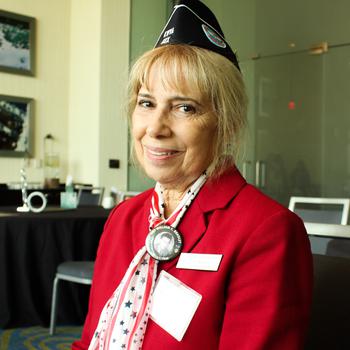
Robin Piacine, who is from Tennessee, has been attending Defense POW/MIA Accounting Agency briefings since 1998. She represented her uncle, Army Sgt. William Charles Bradley, during the Aug. 15-16, 2024, annual briefing held in Arlington, Va. (Caitlyn Burchett/Stars and Stripes)
While the Baldonados wait out technology, Piacine and 5,000 other families might never get the chance to welcome their loved ones home from North Korea and lay them to rest on U.S. soil.
Piacine first attended an annual government briefing in 1998 with her mother and grandmother. Both have since died, leaving only Piacine to continue the mission. Still, she isn’t ready to give up hope that her uncle will be laid to rest in the United States.
“I would hope that if something like that happened to me, somebody in the family would care enough to keep my memory alive,” Piacine said.